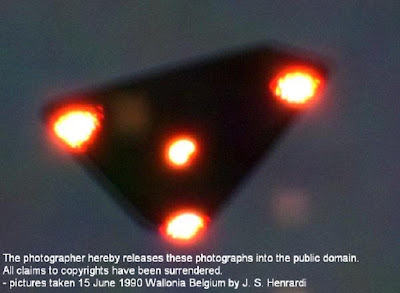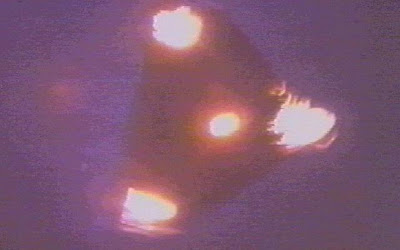The sightings
 The Belgian UFO wave peaked with the events of the night of 30/31 March 1990. On that night unknown objects were tracked on radar, photographed, and were sighted by an estimated 13,500 people on the ground – 2,600 of whom filed written statements describing in detail what they had seen. Following the incident the Belgian air force released a report detailing the events of that night.
The Belgian UFO wave peaked with the events of the night of 30/31 March 1990. On that night unknown objects were tracked on radar, photographed, and were sighted by an estimated 13,500 people on the ground – 2,600 of whom filed written statements describing in detail what they had seen. Following the incident the Belgian air force released a report detailing the events of that night.
Photograph
* Balloons
* Ultralight aircraft (ULM)
* Unmanned aerial vehicles (UAV)
* Aircraft (including Stealth)
* Laser projections or holograms
* Mirages or other meteorological phenomena
Skeptical explanations

Summary: Summary of the offical report by the Belgian Air Force regarding the UFO events of March, 1990.
Background:
1. Starting early Dec 89 the BAF has been contacted on several occasions by eyewitnesses who observed strange phenomena in the Belgian airspace. On some occasions they described the phenomena as a triangle-shaped platform up to 200 feet wide with 3 downward beaming projectors, hovering at +- 100 m above the ground and making only a very light humming noise. Some witnesses saw the object departing at very high speed after a very fast acceleration. All observations were made in the evening or during the night.
2. The radar stations which had been alerted by eyewitnesses could not definitely determine a correlation between the visual observations and their detection on radar. On two occasions the BAF scrambled 2 F16 during the evening hours.
a. On the first occasion the F16 arrived +- 1 hour after the visual detection. Nothing was observed.
b. On the second occasion, pilots could identify a laser-beam projector on the ground. After investigation it appeared however that the description of the observations totally differed from previously described phenomena.
3. Consequently the Belgian Airforce, anxious to identify the origin of the phenomena, authorised F16 scrambles if following conditions were met:
a. Visual observations on the ground confirmed by the local police.
b. Detection on radar.
Events:
4. On 30 Mar 1990 at 23.00 Hr the Master Controller (MC) of the Air Defense radar station of Glons received a phone call from a person who declared to observe three independent blinking lights in the sky, changing colours, with a much higher intensity than the lights of the stars and forming a triangle. Meteo conditions were clear sky, no clouds, light wind and a minor temperature inversion at 3000 Ft.
5. The MC in turn notified the police of WAVRE which confirmed the sighting at +- 23 30 Hr. Meanwhile the MC had identified a radar contact at about 8 NM North of the ground observation. The contact moved slowely to the West at a speed of =- 25kts and an altitude of 10.000 Ft.
6. The ground observers reported 3 additional light spots which moved gradually, with irregular speeds, towards the first set of lights and forming a second triangle.
7. At 23.50 a second radar station, situated at +- 100 NM from the first, confirmed an identical contact at the same place of the radar contact of Glons.
8. At 00.05 2 F16 were scrambled from BEAUVECHAIN airbase and guided towards the radar contacts. A total of 9 interception attempts have been made. At 6 occasions the pilots could establish a lock-on with their air interception radar. Lock-on distances varied between 5 and 8 NM. On all occasions targets varied speed and altitude very quickly and break-locks occurred after 10 to 60 seconds. Speeds varied between 150 and 1010 kts. At 3 occasions both F16 registered simultaneous lock-ons with the same parameters. The 2 F16 were flying +- 2 NM apart. No visual contact could be established by either of the F16 pilots.
9. The F16 flew 3 times through the observation field of the ground observers. At the third passage the ground observers notified a change in the behavior of the light spots. The most luminous started to blink very intensively while the other disappeared. Consequently, the most luminous spot started to dim gradually.
10. Meanwhile the head of the police of WAVRE had alerted 4 other police stations in the area. All four, separated +- 10 NM from each other, confirmed the visual observations.
11. The aircraft landed at 01.10 Hrs. The last visual observation was recorded at +- 01.30 Hrs.
Conclusions:
12. The Belgian Air Force was unable to identify neither the nature nor the origin of the phenomena. However, it had sufficient elements to exclude following assumptions:
a. Balloons. Impossible due to the highly variable speeds (confirmed visually and by radar).
b. ULM. Same as for balloons.
c. RPV. Impossible due to the hovering characteristics.
d. Aircraft (including Stealth). Same as for RPV. No noise.
e. Laser projections or Mirages. Unlikely due to lack of projection surface (no clouds). Light spots have been observed from different locations. Light spots moved over distance of more than 15 NM. Form of inlighted part of spots has been observed with spectacles. Laser projections or mirages can not be detected by radar.
{signed}
W. DE BROUWER Kol Vl SBH
VS3
Belgium Air Force
![]()
UFO Sightings in Belgium, 1990
Famous UFO cases: TR-3B
sources:
Sunday, 31st July 2011 Update!
- Controversial Belgium UFO photo proved to be fake – read full article here!
Belgium UFO Wave
Belgium UFO Triangle Sightings
Short documentary on the significant ufo sightings in Belgium in 1989/90 backed with the refreshing openness of the Belgium airforce and excellent witness testimony and of course very good radar evidence that proves something very unusual took place involving highly advanced technology.The G forces were later calculated at 30G for the mystery craft,this would obviously kill a human pilot.
Belgium Triangle – Top 10 UFO Encounters #7
In the late 1980s, the UFO phenomenon found its way to Belgium, where hundreds of people reported seeing a strange formation of lights in the sky. A very interesting picture emerged from the sightings.


Did you see a UFO during the Belgium UFO wave of 1989 – 1990? <br /><br />If so we would really like to speak to you about your experience.<br /><br />Pioneer Productions a television production company in England are producing a television series about European UFO sightings. <br /><br />We are looking for anyone who saw a UFO in Belgium during these two years who would be happy to talk to us
Why illustrate this with a picture which has been recently revealed by its authors as a hoax made from a polystyrene board ?
In the late 1950 s a light show was created electronicly on a set in a west coast television bradcast studieo, consisting of stage lights, aranged in a v formation. A photo appaired the next in the local news paper. I belive it to be a hoax.
rav.
The Belgian Wave UFO Sightings are definitely some of the most famous and credible sightings.
The 1990 photo taken at Petit Rechain was fake.
In 2011, Patrick Maréchal demonstrated how he had created the hoax UFO, by cutting a piece of styrofoam into a triangle, painting it black, embedding a flashlight in each corner, and hanging it from a string.
imgur.io/a/3tkQgLF